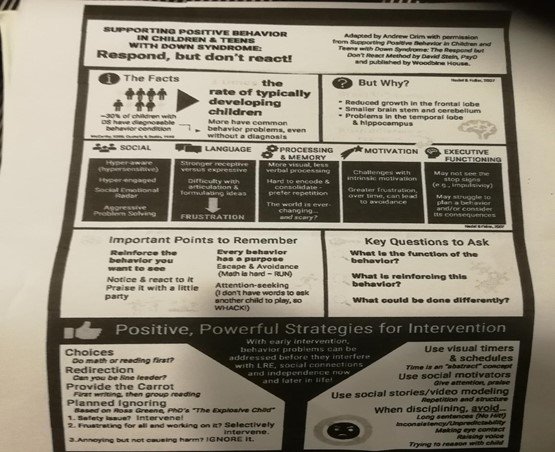Appendix 33 - Managing behaviour
Here are some excellent resources to help parents and teachers to determine if the “behavioural problem” has become significant, discussing some of the common behaviour concerns, how parents and caregivers could approach behaviour issues including considering medical causes as well as situational, environmental and emotional causes:-
https://www.downs-syndrome.org.uk/about-downs-syndrome/lifes-journey/understanding-behaviour/
Supporting Positive Behaviour in Children and Teens with Down Syndrome, The Respond But Don’t React Method, 2016 by David Stein.
Achieving Best Behaviour for children with Developmental Disabilities: A step-by-step workbook for Parents and Carers, Jessica Kingsley 2005.
Down’s Syndrome Association
Barnet Local Offer page
Parenting Support Manuals: There are several parenting manuals which are recommended for families to refer to and which can be purchased online via Amazon: either 1,2,3 Magic by Thomas Phelan, or The Incredible Years by Carolyn Webster Stratton.
Supporting Behaviour Positively
Using the ABC model (Antecedents, Behaviour and Consequences) to work out triggers, accurate descriptions of the behaviour and working out what the behaviour means, and consequences of the behaviour. Work together to provide Positive Behavioural Support with a mixture of proactive and reactive strategies eg to diffuse undesirable behaviours and take away its power, to ignore and redirect, to respond and not react, to understand the learning strengths and challenges in this group of children and young people.
Zones of regulation
One of the most popular systems in classrooms is Zones of Regulation.
WHAT IS ‘ZONES OF REGULATION’?
Zones of Regulation is actually a curriculum that is designed by Leah Kuypers. The curriculum is to help the individuals develop skills to help regulate themselves. Self-regulation is really important for children, and the zones of regulation helps to promote this. The curriculum uses a cognitive behaviour approach. The activities help individuals to learn about each of the four zones, and to recognise when they are in one of those zones.
WHAT ARE ‘ZONES’?
There are 4 zones included in the Zones of Regulation and each zone has its own colour. It’s very important that these colours remain the same. Each of the zones is based on a feeling/emotion/behaviour.
The Red Zone: The red zone is for the most alert and intense feelings. This is to describe feeling angry, out of control, mean etc.
The Yellow Zone: The yellow zone is for when individual’s feelings are heightened, but not to the extreme. This is to describe feeling silly, worried, frustrated, anxious etc.
The Green Zone: The green zone is probably the best zone to be in. This is when the individual is at their best for learning and interacting. The green zone is to describe feeling calm, happy, focused, ready to learn etc.
The Blue Zone: And finally, the blue zone. This is the least heightened of all the zones. This is generally used when the individual is feeling ‘down’ – hence the blue fits nicely here. The blue zone is to describe feeling bored, tired, sick, sad etc.
HOW DOES IT WORK?
Children can complete a variety of different activities to put the Zones of Regulation into practice. The activities will teach individuals the ways that they can recognise what zone they are in. It will also help them to self regulate and get themselves to that important green zone. Teachers and parents can also provide them with the tools they may need. Over time, carers can pull back and allow students to seek those tools they need on their own. The method also recommends putting together some ‘cool down’ boxes for students to have access to. They can contain different things that will help students to self regulate. Many students also respond well to social stories or picture books about different emotions.
BENEFITS:
Students are able to recognise what zones they were in and start to recognise what zones those around them are in. Many children can change mood quickly, and it’s not always easy for those around them to spot the reason why. But sometimes, trying to find out why can actually make the situation worse. The zones of regulation has allowed children/students to recognise their own feelings. This has in turn helped them realise what zone they are in. They then go to our visual chart and look for ways they can calm down – or remember their choices. Without Zones of Regulation, many students can feel like they cannot come back down to calm. This means they would stay at a heightened behaviour for most of the day. This could have an effect on those around them too. The visual poster on display helps give them ideas of how they can calm down. It shows the students that they can get back to the green zone and how they can self-regulate. Using boards, pegs etc to let those around the child know how they are feeling. It gives parents/teachers a heads up and allows them to adapt upcoming events/activities that might cause a knock on effect.

